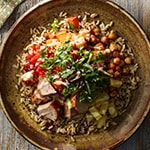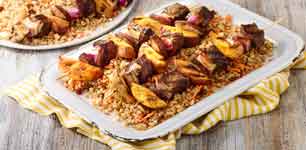 We're celebrating Whole Grains Month this September by highlighting the benefits of eating this important source of nutrients. Americans eat enough grains on average, but most of the time these are refined grains, such as those found in white bread and white rice. Refined grains, when not enriched or fortified, can lack fiber, minerals, and many B vitamins found in whole grains. Don't miss out on those nutrients; choose whole grains at least half the time.
We're celebrating Whole Grains Month this September by highlighting the benefits of eating this important source of nutrients. Americans eat enough grains on average, but most of the time these are refined grains, such as those found in white bread and white rice. Refined grains, when not enriched or fortified, can lack fiber, minerals, and many B vitamins found in whole grains. Don't miss out on those nutrients; choose whole grains at least half the time.
Bountiful Benefits
Eating grains, especially whole grains, provides many nutrients that are vital for good health, including dietary fiber, several B vitamins, and minerals.
Your Daily Whole Grains
The 2015-2020 Dietary Guidelines for Americans recommends that all Americans ages 9 and up make at least half of their grains whole grains, about 3 to 5 servings of whole grains every day. The amount of calories you need may vary according to your age and activity level.
Know Your Whole Grains
Choose foods that feature one of the following whole grains first on the label's ingredient list: brown rice, bulgur, graham flour, oatmeal, whole-grain corn, whole oats, whole rye, or whole wheat.
Source: “Nutrients and Health Benefits." United States Department of Agriculture (USDA): ChooseMyPlate.gov. June 12, 2015.
Taking Steps Toward Better Wellness
The journey toward wellness isn't always easy, but there are many great resources that can provide tips and information to help encourage you along the way.

 You are about to leave publix.com and enter the Instacart site that they operate and control. Publix’s delivery and curbside pickup item prices are higher than item prices in physical store locations. Prices are based on data collected in store and are subject to delays and errors. Fees, tips & taxes may apply. Subject to terms & availability. Publix Liquors orders cannot be combined with grocery delivery. Drink Responsibly. Be 21. For prescription delivery, log in to your pharmacy account by using the Publix Pharmacy app or visiting
You are about to leave publix.com and enter the Instacart site that they operate and control. Publix’s delivery and curbside pickup item prices are higher than item prices in physical store locations. Prices are based on data collected in store and are subject to delays and errors. Fees, tips & taxes may apply. Subject to terms & availability. Publix Liquors orders cannot be combined with grocery delivery. Drink Responsibly. Be 21. For prescription delivery, log in to your pharmacy account by using the Publix Pharmacy app or visiting 
